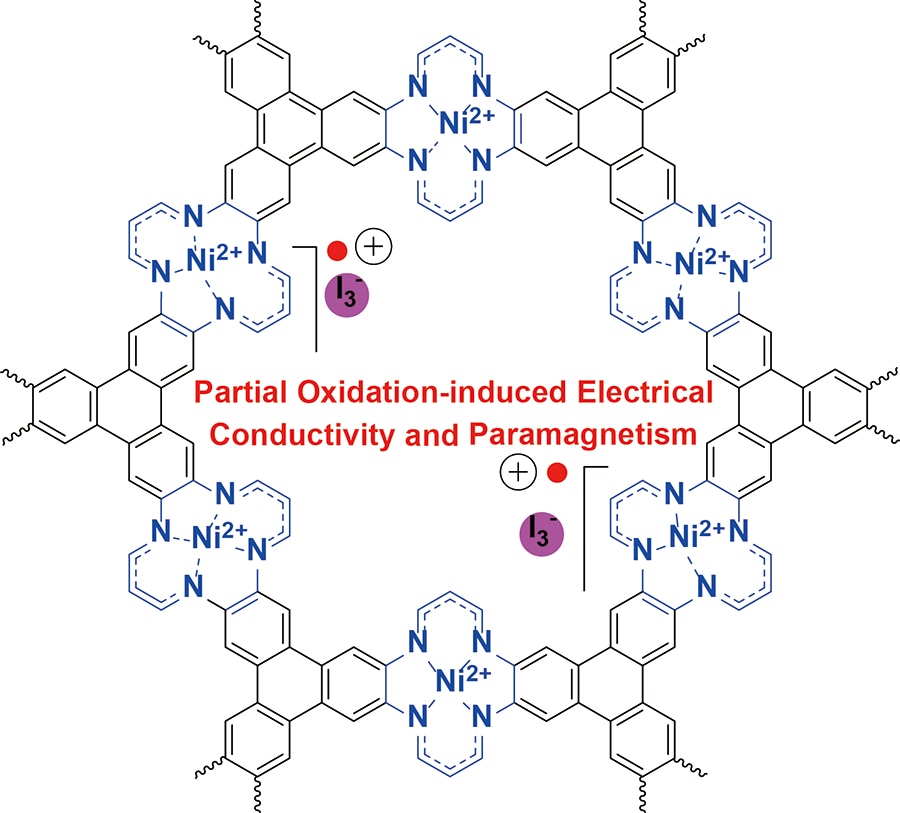Nov 4 2019
Chemists at the Center for Multidimensional Carbon Materials (CMCM) located in the Institute for Basic Science (IBS, South Korea), have demonstrated the synthesis of a unique type of 2D metal organic framework (MOF) with stimulating magnetic properties and electrical conductivity.
 Chemical structure of iodine-doped Ni(II) tetraaza[14]annulene-linked MOF (NiTAA-MOF). While NiTAA-MOF is an insulator, the oxidized molecule acquires electrical conductivity and paramagnetism. (Image credit: Institute for Basic Science)
Chemical structure of iodine-doped Ni(II) tetraaza[14]annulene-linked MOF (NiTAA-MOF). While NiTAA-MOF is an insulator, the oxidized molecule acquires electrical conductivity and paramagnetism. (Image credit: Institute for Basic Science)
This new material may possibly add to photovoltaics, optoelectronics, energy storage, and (photo)electrocatalysis. Details of the research have been published in the Journal of the American Chemical Society.
Also referred to as Swiss-cheese-like or sponge-like materials, MOFs are composed of metal ions connected to organic ligands and are distributed with nano-sized holes.
IBS scientists joined hands with the School of Materials Science at the Ulsan National Institute of Science and Technology (UNIST) to design and synthesize Ni(II) tetraaza[14]annulene-linked MOF (NiTAA-MOF), where the metal portion is nickel and the nickel tetraaza[14]annulene molecules were used as MOF building blocks for the first time.
The scientists learned that doping this MOF with iodine alters its magnetism and conductivity. Pristine NiTAA-MOF conducts below par. It is essentially an insulator with an electrical conductivity of less than 10−10 Siemens per centimeter.
When it is chemically oxidized using iodine, the same measurement expands to 0.01 Siemens per centimeter (the larger this value, the better the conductor). This result proves the crucial role played by ligand oxidation in the electrical conductivity of certain 2D MOFs, offering better insights into the origin of electrical conductivity in this kind of MOFs.
Furthermore, the researchers examined how this material turns out to be magnetized under the influence of an applied magnetic field. Magnetization measurements carried out by the scientists of the School of Materials Science revealed that iodine-doped NiTAA-MOF is paramagnetic. In other words, it is feebly attracted by an external magnetic field, and turns antiferromagnetic at extremely low temperatures.
This implies that it could be beneficial as a polarizing agent in dynamic nuclear polarization-nuclear magnetic resonance (DNP-NMR) that is used in material characterization experiments.
The 2D MOF structure was also modeled through comprehensive calculations and examined by a variety of approaches, such as infrared, electron paramagnetic resonance, X-ray photoelectron, X-ray diffraction, diffuse reflectance UV-vis, and Raman spectroscopies.
Our work can contribute to the fundamental understanding of structure-property relationships in 2D electrically conductive MOFs, and may pave the way to develop new electrically conductive MOFs. Besides, the as-synthesized and iodine-doped NiTAA-MOF might be applicable in catalase mimics, catalysis, and energy storage.
Rodney S. Ruoff, Professor and Study Corresponding Author, Ulsan National Institute of Science and Technology